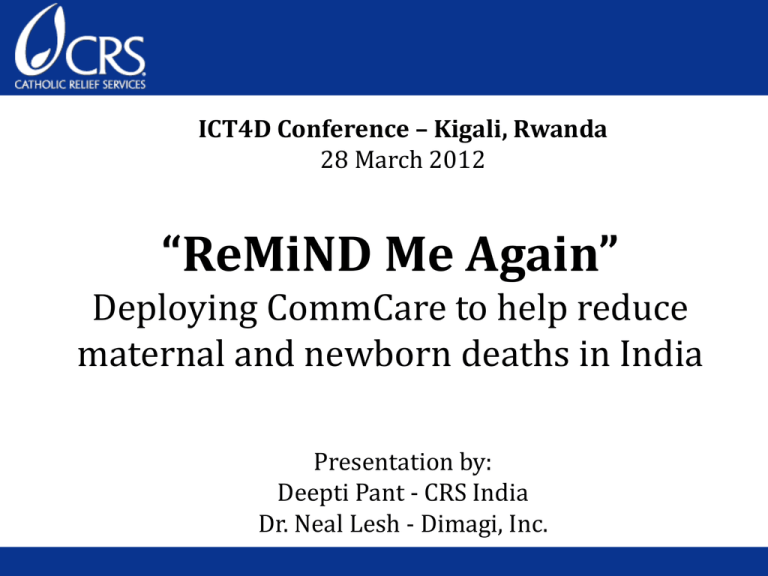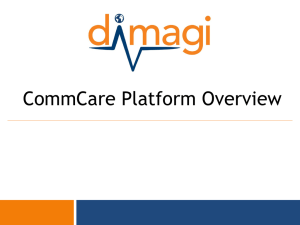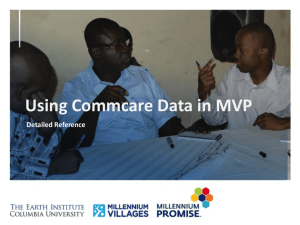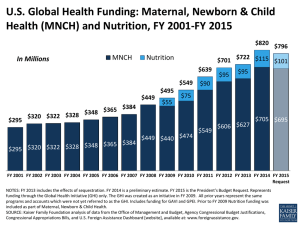ReMiND Me Again CommCare India
advertisement

ICT4D Conference – Kigali, Rwanda 28 March 2012 “ReMiND Me Again” Deploying CommCare to help reduce maternal and newborn deaths in India Presentation by: Deepti Pant - CRS India Dr. Neal Lesh - Dimagi, Inc. Project Location KAUSHAMBI Uttar Pradesh Population - 200 million Maternal Mortality - 345 per 100,000 Newborn Mortality - 50 per 1,000 Infant Mortality - 71 per 1,000 Kaushambi District Population - 1.6 million Maternal Mortality - 442 per 100,000 Newborn Mortality - 59 per 1,000 Infant Mortality - 83 per 1,000 Slide 2 of 16 Challenge • Accredited Social Health Activists (ASHA) struggle to provide timely, comprehensive counseling to women throughout the pregnancy and postpartum periods. • Supportive supervision of ASHAs is limited ICT4D Solution • CommCare – an innovative mHealth platform that allows ASHAs to track and support every pregnant woman, mother and newborn Slide 3 of 16 Technology Requirements • CommCare runs on Java enabled phones as well as Android phones. - Minimum requirements for Java enabled phones: Runs J2ME MIDP2.0 / CLDC 1.1 At least 2MB Java heap At least 1MB max jar size - Example: Nokia C2-01 • Dimagi maintains a central cloud server, CommCare HQ - All data is privacy-protected, backed up, and made accessible to relevant stakeholders. - Accessible through web browsers over the internet. Slide 4 of 16 ASHAs & CommCare – How it works • Filled as soon as ASHA learns of pregnancy • Collects: ID details, Last Menstruation Period, previous pregnancies, live children, Tells Estimated Date of Delivery Pregnancy Checklist • Filled at least once each trimester • Collects: Registration with Auxiliary Nurse Midwife, services availed (Ante Natal check up, Tetanus vaccination), current practices (Iron Folic Acid, work/rest, nutrition, birth preparation), current knowledge • Counsels: care practices, health seeking, danger signs • Filled after delivery or end of pregnancy • Collects: birth outcome Outcome Form Registration Form Slide 5 of 16 Example: Counseling on Iron Folic Acid Consumption Mobile application: “Do you consume Iron Folic Acid?” Pregnant woman: “No.” ASHA: Inputs the response in the mobile application and probes for the reasons. Mobile application describes: - Where it can be accessed - Why it is important - How and when it needs to be consumed Slide 6 of 16 ASHAs & CommCare – Glimpses from the field Slide 7 of 16 Data & Information Flow ASHA inputs data in phone during home visit Performance data & reports shared with ASHA during monthly meetings ASHA uploads data to CommCareHQ using GPRS Weekly and monthly performance reports generated Project staff monitor individual and group activity based on realtime data Slide 8 of 16 Implementation to Date STAGE 1: Preparation of CommCare Applications (April – May’11) CRS & local partner Review Government ASHA guidance & tools CRS & local partner Prepare checklists aligned with GoI Develop mobile application Share with government for their input Dimagi STAGE 2: Beta testing (May-December’2011) CRS, Dimagi, government & local partner Train 10 ASHAs to use CommCare Field test forms and checklists with ASHAs Continuous observation and monitoring Multiple iterations to refine application Slide 9 of 16 Outcomes & Impact Global • Published studies documenting how CommCare can improve access, quality of health services • Randomized control study: timeliness of community health worker visits can increase by 86% through reminders delivered to CommCare users. Kaushambi • ASHAs report that CommCare: - Helps them manage their workload Improves the quality of their counseling Increases families’ receptiveness to key MNH messages • Pregnant women report CommCare’s interactive format makes it easier for them to remember key messages. Slide 10 of 16 Future Plans • Joint planning with District and State health authorities to ensure their early buy-in for CommCare and their participation in new content development • • Scale-up CommCare with 130 ASHAs in Kaushambi District Iteration of CommCare applications for: - Facility-based counseling targeting recently delivered women and mothers-in-law, on Home based newborn & postpartum care - Detection and referral of maternal and newborn danger sign - SMS reminders to ASHAs and missed-visit alerts to supervisors • Capacity building of health authorities and communities on the use of real-time data to inform evidence-based decision making • Monitoring, evaluation, and learning Slide 11 of 16 Implementation Challenges • Appropriate time and staffing must be available in the start-up phase to ensure quality iteration of content and initial roll-out of CommCare to ASHAs. • Initial learning curve of ASHAs who have little or no previous experience using mobile phones • Overcoming the perception among some ASHAs that CommCare will increase their workload. Slide 12 of 16 Sustainability Issues • Ensuring continued government support and buy-in for CommCare, including eventual uptake of phone operation and running costs. Slide 13 of 16 Lessons Learned • Successive iterations of application content are necessary to ensure usability on the part of the ASHA and maximize client engagement and understanding. • Involvement of ASHAs in refining content increases their ownership of CommCare Ongoing Technical Programming and Support Requirements • Retooling CommCare’s reminder technology for the timesensitive post-partum period. • Back-end support from Dimagi for technical trouble shooting, capacity building and technical assistance to CRS in building applications Slide 14 of 16 QUESTIONS : http://www.youtube.com/watch?v=QTjs61L5l2Q











